四年级英语上册教案 4 Unit 1 What are they doing教案 外研社(三起)
四年级英语上册Module4 Unit1教案 外研版
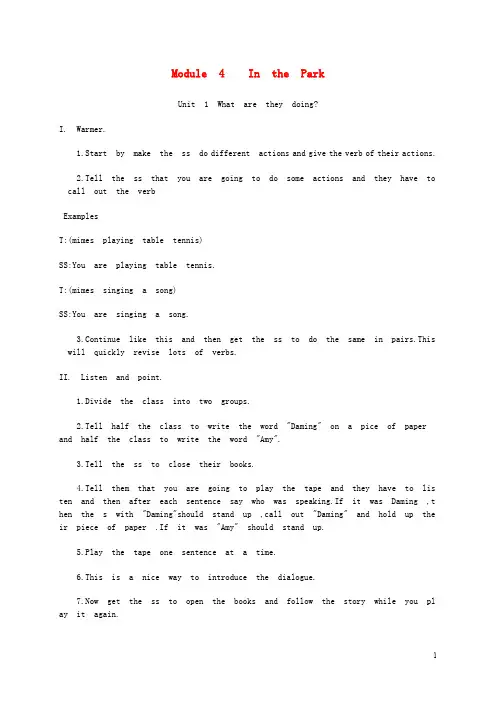
Module 4 In the ParkUnit 1 What are they doing?I. Warmer.1.Start by make the ss do different actions and give the verb of their actions.2.Tell the ss that you are going to do some actions and they have tocall out the verbExamplesT:(mimes playing table tennis)SS:You are playing table tennis.T:(mimes singing a song)SS:You are singing a song.3.Continue like this and then get the ss to do the same in pairs.Thiswill quickly revise lots of verbs.II. Listen and point.1.Divide the class into two groups.2.Tell half the class to write the word "Daming" on a pice of paper and half the class to write the word "Amy".3.Tell the ss to close their books.4.Tell them that you are going to play the tape and they have to lis ten and then after each sentence say who was speaking.If it was Daming ,t hen the s with "Daming"should stand up ,call out "Daming" and hold up the ir piece of paper .If it was "Amy" should stand up.5.Play the tape one sentence at a time.6.This is a nice way to introduce the dialogue.7.Now get the ss to open the books and follow the story while you pl ay it again.III.Act it out.1.Before starting,get the ss to think of as many activities as possible and write them on the board.ActivitiesPlaying footble.Playing table tennis.Brushing my teeth .Washing my face.eating noodles.driving a car.rowing a boat.riding my bike.2.Now put the ss into groups of four.Two ss have to mime actions andthe third s then asks the fourth student what they are doing.3.The fourth s must answer.4.Then get them to change roles and continue.。
PEP人教版小学四年级上册英语Unit4教案
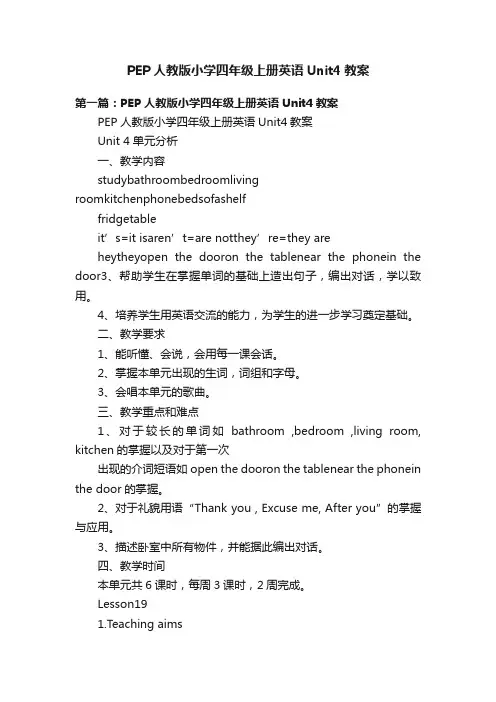
PEP人教版小学四年级上册英语Unit4教案第一篇:PEP人教版小学四年级上册英语Unit4教案PEP人教版小学四年级上册英语Unit4教案Unit 4单元分析一、教学内容studybathroombedroomliving roomkitchenphonebedsofashelffridgetableit’s=it isaren’t=are notthey’re=they areheytheyopen the dooron the tablenear the phonein the door3、帮助学生在掌握单词的基础上造出句子,编出对话,学以致用。
4、培养学生用英语交流的能力,为学生的进一步学习奠定基础。
二、教学要求1、能听懂、会说,会用每一课会话。
2、掌握本单元出现的生词,词组和字母。
3、会唱本单元的歌曲。
三、教学重点和难点1、对于较长的单词如bathroom ,bedroom ,living room, kitchen的掌握以及对于第一次出现的介词短语如open the dooron the tablenear the phonein the door的掌握。
2、对于礼貌用语“Thank you , Excuse me, After you”的掌握与应用。
3、描述卧室中所有物件,并能据此编出对话。
四、教学时间本单元共6课时,每周3课时,2周完成。
Lesson191.Teaching aimsTo act quickly after listening to the T.Master the sentences: This is my home.You can see a bedroom...New words: study bathroom bedroom living roomkitchenPractice: This is my home.You can see a bedroom, a living room…2.Teaching aidsA tape-recorderA pictureSeveral word cards3.Important pointsThe pronunciation of the new words4.Teaching steps1)GreetingsDo some oral work and sing a song.2)New contentsAt first, the teacher shows Amy’s house using the computer.“What can you see in thepicture?”“I can see a study.”“I can see a bedroom.”…….5.Homework WorkTo say the sentences smoothlyListen to the tape and recite the new words.1.Teaching notes Lesson201.Teaching content1)Learn the dialogue and act it out.2)Let them master the sentences1.Teaching aimsMaster the phrases: in the living room, in the study, in your desk, in your hand…Use the dialogue smoothly.3.Important pointsThe pronunciation of the new words4.Teaching aidsA tape-recorderA pictureSeveral word cards5.Teaching steps1.GreetingSing an English song.Ask the students to introduce their homes.2.RevisionLearn the drills and practice the drills.T: What’s this?Ss: An eraser.T: yes, what does it like?S: It looks like a fish.T: Where is my eraser? Is she in the…?Ss: Yes, she is.(No, she isn’t.)Show them several pictures.T: Oh, how beautiful!Where is it?S: This is my bedroom.(This is myLiving-room.This is my bathroom.)T: Is this your..?S: Yes, it is.(No, isn’t.)Game.-Where is my pen?-Is it in the …?-No, isn’t.-Is it in the …?-Yes, it is.Tell them the difference between “Is it…?” and “Is she…?”Listen to the tape and imitate.Practice in groups and act it out.6.HomeworkTo say the sentences smoothlyRecite the dialogue and listen to tape.2.Teaching notesLesson 211.Teaching AimsLet them master the words :homeroomschoolclassroom(listeningspeakingreadingand writing)And the sentencesWelcome to my ……home ……This is my ……room ……When they see the pictures, they can recognize and say their English names..2.Teaching Aidsa tape recordercardspictures3.Important points4-skill words:homeroomschoolclassroom4.Teaching steps1).Greeting and organizationSing an English song and do oral work.2).RevisionA:Act the dialogue of lesson 21B: Review these words:Homeroomschoolclassroom3).PresentationRead the words and spell them.Ask a student come to the front to read all the words, and the others after him or her.4).PracticeListen to the tape, imitate and practice the sentences.Read and spell the words.5.HomeworkSpell the words , then write them:Homeroomschoolclassroom1.Teaching notesLesson221.Teaching AimsLet the students master the words and phrase :phonebedshelffridgetablesofaLet the students listen and read these drill:Sit on …Make …Watch TV.Answer…Open…Set…2.Teaching Aidsa tape recordercardspictures3.Important pointsLearn to say the words: phoneshelffridgetablesofaWhen they see the subject, they can recognize and say their English names..4.Teaching steps1).Greeting and organizationSing a song and do a oral work.2).RevisionReview these words:Homeroomschoolclassroom3).PresentationThe teacher shows the phone of the room and points at somethingone by one, and the students say it in English.In this way, learn to say the new words:phoneshelffridgetablebedsofaAsk a student come to the front to read all the words, and the others read after him.4).Play a game:Passing the eight words between eight groups, and then checking which group did quickly and right.5).Practice Listen to the tape, imitate and practice the words:phone…Read and spell the words.6).Let’s doSit on the sofa.Make the bed.Watch TV.Answer the phone.Open the fridge.Set the table.5.Homework1.Listen and read the new words and drill.2.Recite “Let’s do”.2.Teaching NotesLesson231.Teaching content1)DrillsA: Are they on the …?A: Are they near…?B: Yes, they are.(No, they aren’t.)2)Learn the dialogue and act it out.3).Let’s chant.2.TeachingaimsLet them master the short sentences:Open the dooron the tablenear the phoneLearn the new e the dialogue smoothly.3.important points1).The pronunciation of the new words2).A: Are they on the …? B: Yes, they are.(No, the arearen’t)4.Teaching aidsA tape-recorderA pictureSeveral word cards5.Teaching steps1).Greeting and organizationSing an English song and do oral work.Ask the students to introduce their home.2).At first, the teacher talk to the students.T: Where are the key(book…)?S: It’s on the table(in the desk, near the phone…)T: Where are the keys(books…)?S: They are on the table(in the desk, near the phone…)T: Are they on the table?S: Yes, th ey are.(No, they aren’t.)Then learn to say the drills.And practise the drill with the Ss.From “the T asks, theS answers” to “the S asks, the S answers.”3)Then practise these drills smoothly.Play a game.S1:Where are the keys? S2:Are they in he …?S3: No, they aren’t.S2: Are they in the …?S3: Yes, they are.Tell them the different of “Is it…?” or“Are they…?”Listen to the recorder and imitate.Work in groups and act it out.6.HomeworkRecite the dialogue.To say the sentences smoothly3.Teaching notesLesson 24.Teaching Aims1)Let the students master the four-skill words :Windowdeskdoorchairbed2)Let the students read these sentences:What can you see in my room? I can see…When they see the objects, they can recognize and read them and do the action about them.2.Teaching Aidsa tape recorder.3.Difficult words and emphasis:4-skill letters and words:Windowdeskdoorchairbed4.Teaching steps1)OrganizationChant together and do a oral work.2).RevisionSpell the word: WindowdeskdoorchairbedPhrase: w_nd_wd_ _rd_skch___b_d3).PresentationWhen the teacher point at the subject, the students say the word and spell it.Then write thesewords.Read the drills smoothly:What can you see in my room?I can see…Read and choose: Listen to the T and choose A,B,C or4).Listen to the tape, imitate and read..5).GameThe teacher asks a student come to the front of the class, and tell him/her a word, then asks other students guess the word.5.HomeworkSpell and write the four-skill words :第二篇:pep版小学英语四年级上册unit4教案Unit 4 My home第一课时教学目标:知识与技能:1、能听懂、会说:Welcome to my home!并能描述自己的房间。
译林版英语四年级上册第四单元教案
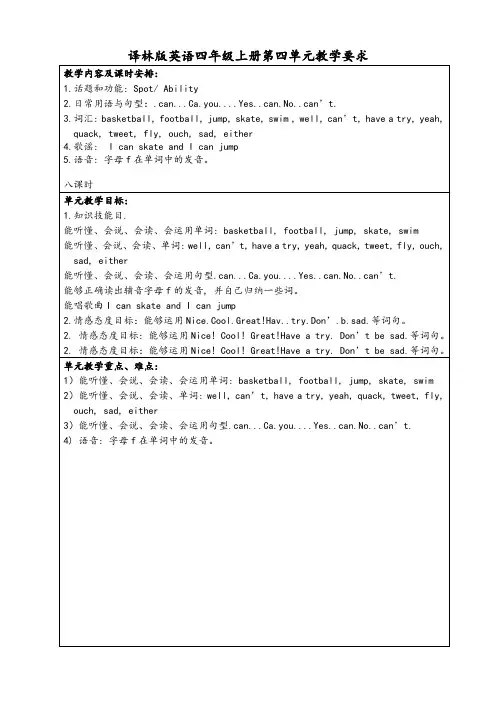
能够正确读出辅音字母f的发音, 并自己归纳一些词。
能唱歌曲I can skate and I can jump
2.情感态度目标:能够运用Nice.Cool.Great!Hav..try.Don’.b.sad.等词句。
Step 2 Presentation
1.读一读黑板上的表示动作的单词及赞美性的语言。
2.请同学运用句型Ca.you....Yes..can.No..can’t.来自由问答。
S1.Hello.....Ca.you..... S2.Yes..can..S1.Nice!.Cool./Great./Wonderful!
S.H.ca.pla.football. (出示词组pla.football)
T: What can he do?
S: He can play basketball.(通过预习, 应该有同学能说出来)
T: Wonderful! (出示词组 play basketball, 教学朗读)
观察单词football 足球, foot是脚, ball球, 用脚踢的球, 谓之足球。
T.(做动作..ca.swim.Ca.yo.swim.S.Yes..can..No..can’t.
T..ca.skate.Wha.ca.yo.do.S..can...
T.Wha.abou.you.. S..can....
(老师在与学生对话的过程中, 遇到学生说的已学的动作类的单词, 可以请同学拼一拼, 并板书, 老师针对学生的回答, 可以用Nice! Cool! Great! Wonderful!等语言来进行表达, 同时也为本课的内容服务, 老师可以出示准备好的这些单词的卡片, 直接贴在黑板上。)
四年级上册英语教学设计-Unit 1 What are they doing?-外研社(三起)
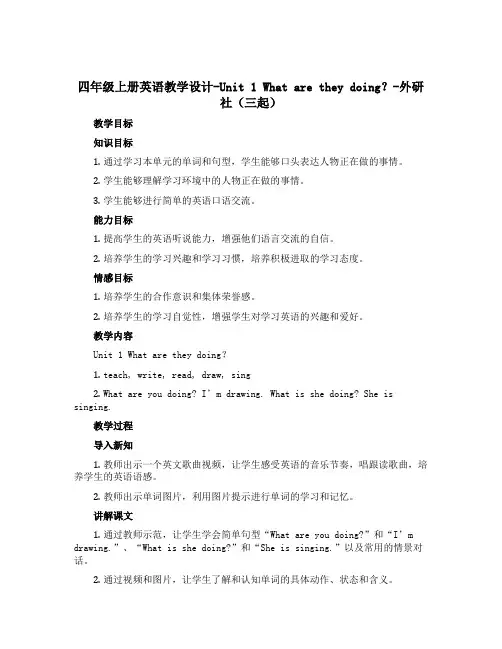
四年级上册英语教学设计-Unit 1 What are they doing?-外研社(三起)教学目标知识目标1.通过学习本单元的单词和句型,学生能够口头表达人物正在做的事情。
2.学生能够理解学习环境中的人物正在做的事情。
3.学生能够进行简单的英语口语交流。
能力目标1.提高学生的英语听说能力,增强他们语言交流的自信。
2.培养学生的学习兴趣和学习习惯,培养积极进取的学习态度。
情感目标1.培养学生的合作意识和集体荣誉感。
2.培养学生的学习自觉性,增强学生对学习英语的兴趣和爱好。
教学内容Unit 1 What are they doing?1.teach, write, read, draw, sing2.What are you doing? I’m drawing. What is she doing? She is singing.教学过程导入新知1.教师出示一个英文歌曲视频,让学生感受英语的音乐节奏,唱跟读歌曲,培养学生的英语语感。
2.教师出示单词图片,利用图片提示进行单词的学习和记忆。
讲解课文1.通过教师示范,让学生学会简单句型“What are you doing?”和“I’m drawing.”、“What is she doing?”和“She is singing.”以及常用的情景对话。
2.通过视频和图片,让学生了解和认知单词的具体动作、状态和含义。
课堂练习1.在学生理解了课文和句型后,让学生两两分组,进行小组间的口语练习。
一个同学出示图片,另一个同学需要问出对方正在做的事情。
加强学生的英语口语交流能力。
2.教师出示图片,让学生依据图片理解人物正在做的事情,再用英语口头表达出来。
加强学生的英语听力和口语表达能力。
课堂延伸1.让学生在课后选取一件自己喜欢的事情,将自己正在做的事情用英语口头表达出来,然后给同桌或家长听并纠正语音和语法错误。
加强学生的英语口语自我练习能力。
2.给学生布置家庭作业,要求学生在练习过程中使用英语语言,并写下练习过程和心得体会。
外研版小学四年级上册英语教案Module 4Unit 1 What are they doing
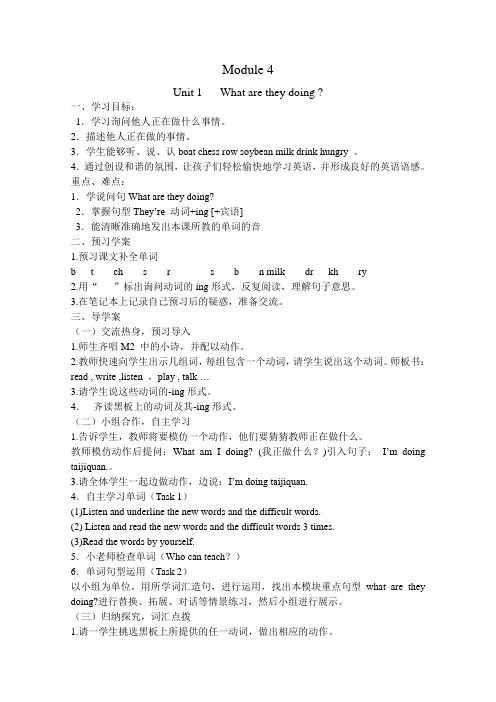
Module 4Unit 1 What are they doing ?一、学习目标:1.学习询问他人正在做什么事情。
2.描述他人正在做的事情。
3.学生能够听、说、认boat chess row soybean milk drink hungry 。
4.通过创设和谐的氛围,让孩子们轻松愉快地学习英语,并形成良好的英语语感。
重点、难点:1.学说问句What are they doing?2.掌握句型They’re 动词+ing [+宾语]3.能清晰准确地发出本课所教的单词的音二、预习学案1.预习课文补全单词b t ch s r s b n milk dr kh ry2.用“”标出询问动词的ing形式,反复阅读,理解句子意思。
3.在笔记本上记录自己预习后的疑惑,准备交流。
三、导学案(一)交流热身,预习导入1.师生齐唱M2 中的小诗,并配以动作。
2.教师快速向学生出示几组词,每组包含一个动词,请学生说出这个动词。
师板书:read , write ,listen ,play , talk …3.请学生说这些动词的-ing形式。
4.齐读黑板上的动词及其-ing形式。
(二)小组合作,自主学习1.告诉学生,教师将要模仿一个动作,他们要猜猜教师正在做什么。
教师模仿动作后提问:What am I doing? (我正做什么?)引入句子:I’m doing taijiquan.。
3.请全体学生一起边做动作,边说:I’m doing taijiquan.4.自主学习单词(Task 1)(1)Listen and underline the new words and the difficult words.(2) Listen and read the new words and the difficult words 3 times.(3)Read the words by yourself.5.小老师检查单词(Who can teach?)6.单词句型运用(Task 2)以小组为单位,用所学词汇造句,进行运用,找出本模块重点句型what are they doing?进行替换、拓展、对话等情景练习,然后小组进行展示。
四年级英语上册 Module 4 Unit 1(4)教案 外研版
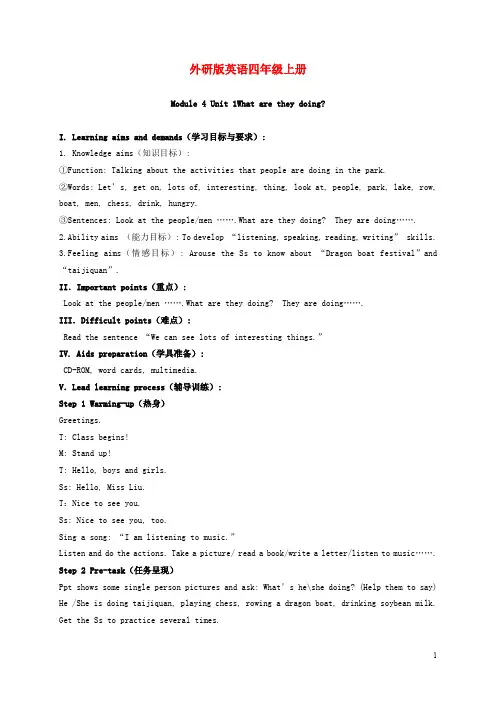
Blackboard writing:
Listen again and answer the questions: What are they doing? What are they drinking? Some people are dong Taijiquan,where are they? Some people are rowing boat, where are they?引导学生得出答案in the park\on the lake\under the tree.
Ss: Hello, Miss Liu.
T:Nice to see you.
Ss: Nice to see you, too.
Sing a song:“I am listening to music.”
Listen and do the actions. Take a picture/ read a book/write a letter/listen to music…….
2.Ability aims(能力目标): To develop“listening, speaking, reading, writing”skills.
3.Feeling aims(情感目标): Arouse the Ss to know about“Dragon boat festival”and“taijiquan”.
pep版小学英语四年级上册unit4教案
pep版小学英语四年级上册unit4教案第一篇:pep版小学英语四年级上册unit4教案Unit 4 My home第一课时教学目标:知识与技能:1、能听懂、会说:Welcome to my home!并能描述自己的房间。
2、听、说、认读单词:study, bathroom, living room, bedroom, kitchen。
3、能听懂Let’s do中的指示语,并能做出相应的动作。
4、学唱歌曲My bedroom.过程与方法:情景教学法情感态度价值观:学会用英语描述自己的家,热爱自己的家;敢于表达教学重点:1、听、说、认读单词:study, bathroom, living room, bedroom, kitchen。
2、学习表示指令的词组。
教学难点:单词study, bathroom, bedroom的发音。
教具准备:1.教材相配套的教学录音带2.教师自制的单词卡3.教师使用的study, bathroom, bedroom, living room, kitchen 图片。
教学过程:一、热身、复习(Warm-up / Revision)A.Learn these sentencesWhere is the doll? It is in the box.Where is the doll? It is on the box.Where is the doll? It is under the box.Where is the box? It is on the table.B.Ask and answerWhere is the farmer? He is in the van.Where is the monkey? It is under the taxi.Where is the elephant? It is in the car.Where is the boy? He is on the train.Where is the nurse? She is on thebus.Where is the girl? She is in the truck.Where is the bird? It is on the bridge.二、呈现新课(Presentation)1.教师出示study的图片,手指着书房里的书问学生:What are they? 学生回答:They are books.教师接着自问自答:Where are the books? They are in the study.教读单词 study, 并板书,让学生认读。
英语四年级上册第一单元第四课时 教案
四、拓展(Extension)(此环节用时10分钟)
(一)活动运用,任务落实
1.任务活动中运用——学以致用
1、活动“我是班级的小主人”
运用本单元学过的语言做一次情景大扫除,在活动中运用到本单元的
学生说完一句,教师都应不失时机地回答All right或Ok!
5、小总结
出示板书:
Let’sclean the classroom. OK!
Let meclean the windows.
Letme help you! Thankyou.
Let’s…是建议让我们做什么事情,是一个人对其他人说的话,意思是让大家和自己一同做一件什么事。
2.练习任务中落实——随堂检测k
(二)总结赏析,情感升华
在活动“我是班级的小主人”运用本单元学过的语言做一次情景大扫除,在活动中加强对学生进行热爱班集体和热爱劳动的教育。教师指着黑板上的教室图说:This isBoy’sclassroom.Andthis isGirl’sclassroom.Whoes classroom is chean? Let’s go and have a look.让学生和教师一起评价哪个教室的布置最合理整齐,哪组即为获胜者,获胜者将得到教师的奖励,失败者也会得到教师的鼓励,争取下一节课获胜。
2.养成爱劳动的良好习惯。
二、知识技能目标:
1.能听懂,会说本课时的句型“Let’s clean the classroom! OK!和Letme clean the windows. Thank you.并能在情境中运用.
外研版教材四年级上册第四模块第一单元《What are they doing-》教学设计和反思
外研版教材四年级上册第四模块第一单元《What are they doing?》教学设计和反思本课是外研版教材四年级上册第四模块第一单元《What are they doing?》的第一课时,本单元主要教学内容为有关现在进行时态的问答.学习询问他人正在做什么.能运用What are they doing ? What is he/she doing ? I’m (doing)…. He /she is (doing)….等句型询问以及描述对象所进行的动作或所处的状态,进行展开一系列的交际活动和任务。
学情分析本节课是第四模块第一单元的第一课时,而本节课是学生学习现在进行时的第一节课,因此,对学生接受现在进行时的概念,理解现在进行时的用法显得尤为重要。
教学目标1.通过具体而典型的情景,体会现在进行时的用法,能够运用句子What are you doing ? 询问别人正在做什么,并用 I’m ___ing . 这一陈述句来做答。
同时感知并尝试用“You’re doing sth.“描述对方正在干什么。
2.学生能够听、说、认boat\chess\row\soybeanmilk\drink\hungry.3.通过创设和谐的氛围,让孩子轻松愉快的学习英语,并形成良好的英语语感。
4、培养学生热爱生活的美好情感,引导学生注重合作,培养沟通和交流的能力。
教学重点和难点重点;1、学说问句 What are they doing ?2、掌握句型They are动词+ing(+宾语)难点:1、能清晰准确地发出本课所教的单词的音,自如的应用。
2、引导学生感知、理解现在进行时所表达的含义。
教学过程教学环节教师活动预设学生行为设计意图一、Warm-- up 二、 Preview 三、Presen-Tation四、Conso-lidation.五、Homework 学生听唱歌曲“listening to music”师板书动词read\write\listen\play\talk\take 1.教师请一学生挑选黑板上所提供的任一动词做出相应的动作师同时提问:What is she/he doing? 2.教师故作不解状问:What are they doing?后又释然说:“Oh,they are 动词+ing【+宾语】并板书。
外研版四年级英语上册Module 4 Unit 1 What are they doing 公开课教学设计
外研版Module 4 Unit 1 What are they doing ?公开课教学设计一、教学目标1、知识目标语句:What are they doing ?They are ….单词:let’t、 interesting、 thing 、people、 park、 lake、 row 、boat、men、 chess、 drink、 hungry短语:get on 、lots of 、look at2、能力目标能够运用所学句型和短语描述人们正在进行的动作。
3、情感目标学会细心观察,与他人合作和关心他人。
二、教学重难点重点:1、学说问句What are they doing ?及答They are ….2、掌握句型They are 动词+ing 〔+宾语〕难点:能清晰准确地发出本课所学单词的读音。
三、教学方法直观教学法、对话演示法、游戏法、情景教学法、活动教学法和全身反应法。
四、教具:卡片、录音机五、教学过程(40mins)Step 1 热身(3mins)(1)GreetingsT: Class begins. Good morning boys and girls.Ss: Good morning Ms Guo.T: How are you?Ss: Fine , thank you , and you?T: I’m fine , too.(2) Sing a song “I am listening to music.”鼓励学生根据歌词内容做出相应的动作。
Step 2 复习引入新课(5mins)复习上一模块所学的语言。
①、以单词卡出示单词take a picture, read a book ,write a letter ,listen to music, talk to a friend ,play with dolls 等,请学生说出单词并演动作。
②、出示图画卡片,问What is he/she doing ?请单个学生回答,进行充分的练习后,请较好的学生当小老师,向其他同学提问。
- 1、下载文档前请自行甄别文档内容的完整性,平台不提供额外的编辑、内容补充、找答案等附加服务。
- 2、"仅部分预览"的文档,不可在线预览部分如存在完整性等问题,可反馈申请退款(可完整预览的文档不适用该条件!)。
- 3、如文档侵犯您的权益,请联系客服反馈,我们会尽快为您处理(人工客服工作时间:9:00-18:30)。
6.再请一组学生挑选黑板上所提供的任一动词(不能重复),做出
相应的动作,教师请其他学生回答问题:What are they doing ?然后教师把正确答案写在黑板上。
7.请学生一起认读黑板上的句子。
(二)学习新动词
1.告诉学生,教师将要模仿一个动作,他们要猜猜教师正在做什么。
2.教师通过提问:What is he/ she doing ?复习He’s/ She’s动词+ing [+
宾语]。
3.请该生所在组的成员模仿该生的动作,并做动作边说:I’m动词+ing
[+宾语]。
4.教师故作不解状问:What are they doing ?后又释然说:Oh. They’re
动词+ing [+宾语],并板书。
9.教师拿着豆奶走到学生中,到边“喝”边说:Soybean milk is very
nice. Soybean milk is very nice.提问学生What am I drink?由此教说soybean milk(豆奶)并板书。
10.请一些学生模仿喝豆奶的动作,比比谁表演的最好。其间老师可以适时用What is he/ she doing ? What are they doing ?提问其余学生。
教学重点难点
教学重点:1)学说问句What are they doing?
2)掌握句型They’re动词+ing [+宾语]
教学难点:能清晰准确地发出本课所教的单词的音,
并自如地应用。
教学方法
直观教学、
师生活动过程
设计图
一、Warming up
师生齐唱M2中的小诗,并配以动作。
二、Revision
1.教师快速向学生出示几组词,每组包含一个动词,请学生说出这个动词。师板书:read , write ,listen,play , talk…
2.请学生说这些动词的-ing形式。
3.齐读黑板上的动词及其-ing形式。
三、Presentation
(一)学习新句型
1.请一学生挑选黑板上所提供的任一动词,做出相应的动作。
五、Homework
1.抄写单词:row , play, drink, boat, milk
2.收集有关人物或动物正在进行某种动作行为的
照片、图片、图案,并用英语说说他们正在做什么?
从旧知自然过渡到新知。创设场景,与学生交流,在自然的语言交流中既温习了旧知又整体呈现新知,让学生在自然的交流中学得和习得语言。
2.教师模仿动作后提问:What am I doing? (我正做什么?)引入句子:
I’m doing taijiquan.。
3.请全体学生一起边做动作,边说:I’m doing taijiquan.教师通过提
问:What are they doing ?引入句子:They’re doing taijiquan.并板书。
2.请自愿上台的学生背朝大家,选择其中的一个数字,教师翻开此卡片的反面示以台下的同学,台下学生根据卡片上的内容做出相应的动作。
3.台上的同学必须用英语They’re动词+ing [+宾语]来猜测台下同学所做的动作。如果说对了,台下同学要说“Yes”,若连猜3次不中,可用What are they doing?请求他的朋友,帮忙回答。
4.用类似方法教They’re row a dragon boat.并板书。
5.教师拿出一副国际象棋问学生What’s this ? Do you want to play ?
并告诉他们老师将邀请他们一起玩,但玩之前必须先学会说play chess,并板书。
6.教说chess, play chess。
2.四人小组中,请学生A和B向学生C和D模仿一个动作,然后由C和D提问:A和B在做什么?
3.让小组内学生互换角色。
4.请几位学生到教室前模仿动作,教师提问:What are they doing ?然后让全班或个别学生回答。
(三)游戏
1.教师在黑板上贴上正面写有数字,反面写有:
do taijiquan, row a boat, play chess等动词词组的卡片。
四、Consolidation
(一)快速反应
1.请几位学生到教室前,由教师说动词词组,学生模仿动作,比比谁的反应最灵敏。
2.让学生在小组内进行训练。
(二)表演
1.请学生打开课本P15,教师指着人们划船的图问
学生:What are they doing ?学生应回答:They are rowing a boat.
课题
Module 4 Unit 1 What are they doing?
课型
新授课
教学目标
1)学习询问他人正在做什么事情。
2)描述他人正在做的事情。
3)学生能够听、说、认boat chess row soybean milk drink hungry。
4)通过创设和谐的氛围,让孩子们轻松愉快地学习英语,并形成良好的英语语感。
]
教学手段的多样性能使学生的大脑始终处于兴奋状态。因此采用形式多样、贴近学生实际的练习方式,适合本阶段学生的学习心理特点,引导他们积极参与,更好地理解和掌握所学的知识.
教学反思
通过本节课的学习,学生基本上都会用What is she/he doing?句型打听别人正在干什么,也能用今天所学的动词的ing形式的词组进行回答,教学过程从复习旧知、讲授新知到操练、总结,能做到由简到难,层层递进,能有效地调动学生思维、表达,既重视知识的形成过程,又注重了学生的思维发展过程,为下一课的学习打下坚实基础。
7.教师做饥饿状说:I’m hungry. I’m hungry.板书hungry(饿的)并
重复说多遍,再提问学生:What’s the matter with me?由此教单词hungry(饿的)。
8.教师从包中拿出一瓶豆奶说:I want to drink soybean milk.边“喝
边说:drink drink , I’m drinking.让学生模仿跟着教师重复句子并模仿动作。
